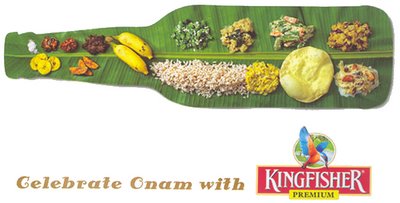Wednesday, August 30, 2006
Friday, July 07, 2006
Trebiking (Biking + Trekking) to Edukumeri
Crew:
Vineet
Mahesh
Ravikiran
Kiran (Vineet's Friend)
Jagadish
Date of Journey:
29-Apr-06 To 01-May-06
Kee..Kee…Keee..Keeeeeee…Some sound was coming from nowhere…with difficulty I opened my eyes and looked around. I saw the time and it was 5.00 AM. Then I realized the source of that sound..yes baba..it was my mobile alarm. I saw a new SMS from Jagga saying ‘Wake Up’ which came at 4.45 AM. How I can get up from a mere SMS??..Idiot…The reason for getting up so early is we (5 Boyz) had planned a biking trek (confused??...Go on reading!) to Edukumeri Via Bisile. And we are supposed to meet at 6.00 AM sharp Opp. to ISCKON temple. So I got ready and kick started my bike at 5.30 AM..and Zoom. I was the second one to reach there, Mayya was already there. By 6.30 AM everyone arrived on their bikes. We filled petrol full tank and started our journey.

We crossed Bangalore at almost by 7.15 AM and hit on NH-48 road. Nobody was in mood of hurry to speed the vehicles. Believe me….The NH-48 is awesome road for bikers. It’s like tasting ice cream in middle of summer. After crossing Kunigal, at certain gap of drive, we came across “Hebbagilu” on the right side. Opposite to that, to our left side, one road was visible. We hit that road on left side and even though road was rough, muddy and with potholes, we drove with great enthu to out first destination. The Marconahalli Dam.

We parked our vehicles outside the gate at 9.00 AM, crossed a park which had trees standing tall and we started climbing with our luggage to the top of the Dam. When we reached top of Dam…..I was dumbstruck with its beauty…I shouted “Wow Man”…..In front, the entire scene was filled with water 60 feet deep and fresh cold air blowing to our face. Backside, the scenery was very beautiful park but not maintained clean. I guess very less attention is paid to maintain it as visitors to this dam are rare case and also there is no publicity. There are lengthy chairs (similar to present in railway stations or parks) present to sit and watch the view on top of the dam.
 There was man who maintained that Dam showed us how the dam worked, how they leave water on other side. There was huge metal covering standing on top of dam with metallic pillars on four sides with letters ‘England’ inscribed on it. I guessed it could be made in England and on same time I wondered how they brought it here from England. Then there was display board of all statistics and measurements related to dam.
There was man who maintained that Dam showed us how the dam worked, how they leave water on other side. There was huge metal covering standing on top of dam with metallic pillars on four sides with letters ‘England’ inscribed on it. I guessed it could be made in England and on same time I wondered how they brought it here from England. Then there was display board of all statistics and measurements related to dam.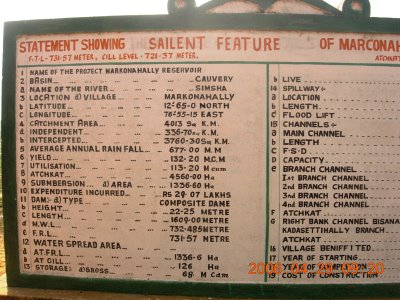
We climbed down and we went to bottom side of Dam at the Park side. There were 2 big holes to release water from other side. We left Dam at 9.30……and hit the rugged looking road which took back to NH-48 and continued our journey.
We reached Yadiyur at 10.10 AM and we came across yet another “Hebbagilu” on left side. Here, we took left turn into the town and went straight until we reached our second destination “Mahabalashwara Temple”. Vineet and Jagga went inside the temple while other 3 were waiting. Mean time, I saw a Chariot (“Ratha”) standing opposite to temple. It had some beautiful carvings on all its sides. One elder person of that town who was watching us (Me and Mayya) came near and started explaining all the figures carved on the chariot. The carvings which surprised me were of intimate scenes with one or more persons and more of surprise, it included intimate scene with animals also. I was shocked and was not able to digest this. How could they carve such things on chariot which carries God on festivals?
After Vineet came back, we made our bikes to stand in line horizontally..and did pooja and hit the coconut in front of our bikes for our safe journey.
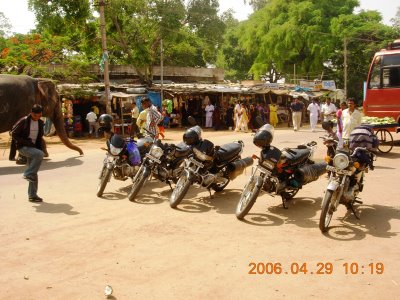 Later we drove back to NH-48 and continued our journey to next destination “The Gorur Dam”. On the way we came across green patch of grass and then we took rest for few minutes under a tree.
Later we drove back to NH-48 and continued our journey to next destination “The Gorur Dam”. On the way we came across green patch of grass and then we took rest for few minutes under a tree.
On the way to Hassan, you come across 4 way junction which takes to Sakleshpura to right side and Gorur to left side. We took left turn and reached Gorur at 2.30 PM. The Road from NH-48 to Gorur was too good with curvy paths and trees planted alongside the road, thereby experiencing AC effect through out the journey. With this type of road, all 5 drove like crazy at 80km/hr in single bee line. It looked like some bike race is going on.

After reaching Gorur, we came near to the gates of the Gorur dam. The security asked to bring permission letter from authority person whose office was 1km back from where we came. Since it was lunch time, the security told officer would have gone for lunch and we have to wait until he comes and get permission letter. But later, he decided to allow us to see the dam and asked us to tell inside officers that we could not get permission since it was lunch time only if they enquired. We parked our vehicles inside the gate under beautiful tree which had red flowers all over. While walking near to the dam, we were able to see letters “Narmada dam” carved in huge size on either side, one in English and other in Kannada.
 We climbed steps to reach the top of dam to have lovely sight of water flowing and hitting the dam. The walls towards the water were in sliding shape covered with large square like stones… with few stones blocks protruding at a certain distance at regular intervals. We climbed down and took some snaps on these stone blocks.
We climbed steps to reach the top of dam to have lovely sight of water flowing and hitting the dam. The walls towards the water were in sliding shape covered with large square like stones… with few stones blocks protruding at a certain distance at regular intervals. We climbed down and took some snaps on these stone blocks. 
We had lunch at around 3.00 PM there itself. We went to temple which is situated opposite side of the dam, residing nearby a river.

We took our bikes near to that river, washed our faces, took some rest and continued our journey to Bisile. Instead of going back, we just took the road from Gorur Dam and continued further towards Shanivarasanthe via Mallipattana.
On the way we came across a road where it takes to Sakleshpura on right side and Bisile to left side. So we hit the roads on left side and continued towards Bisile. Our main aim was to see sunset at 6.00 PM at View point. The path was not smooth, it was muddy road with pebbles around. We came across a circle with 4 roads which again takes to Sakleshpura (32kms from there) on right side. One road was towards Bisile which was around 14 kms. The Nut in the metallic cover for chain socket got loosened in Jagga’s Bike and fell down somewhere on the road. So near the circle, there was repair shop where the repair fellow did some stuff to keep the covering. Meanwhile we all had rounds of Tea and Badam Milk. Then we kicked our bikes towards Bisile. After reaching Bisile, We have to cross police check post and continue further to reach the view point. When we reached view point at 6.20 PM, last visitors were leaving the place. We scouted on top of the view point for some time until 7.00 PM .and then we climbed down to our bikes. Luckily the main gates were not locked. So we took the advantage by opening the gates and rode our bikes to view point itself and parked on left side where there was flat area suitable for parking. We later closed the gates as it is after we got inside.

The black clouds were there on top of our head hence we could not see sun set. Alas!! From view point, the scenery was ultimate as good as painting. We could see Giribetta which was highest peak along with Kumara Parvatha to its right. There was display map of all mountains which were visible along with their names. We pitched tent there and we laid down our sleeping mats. We rested our backs on the mat and ate our snacks while we chatted. We had our dinner (chapattis with Chutney powder) and we slept at 9.00 PM.

It was very hot inside the tent and nobody was ready to sleep outside as we had heard some rumors that cheetahs frequent these places. We had taken candles to light them whole night.
We got up at 5.00 AM after having bad night (Could not sleep properly because of Kiran’s loud snoring L which was similar to Tiger….may be this effect was due to tiger biscuits eaten last night). We removed tent and packed our entire luggage. Vineet told there is one more view point at some distance. I was not interested as sun was hiding still even thought it was 6.00 AM. As rest of 4 were enthu to go there, I stayed back while they went to the view point and returned at 6.30 AM. Then we took our bikes down the view point onto the road, closed the gates as it was when we arrived, and moved on.
We had travel back on same road as we came through Bisile to a village called JagaTa. We came across lot of 2 road junction on the way…and we had to ask the villagers for the right direction. The journey was not an easy one. We have to go through muddy track initially, and then road full of pebbles which are waiting to make your bike to slip and slide.
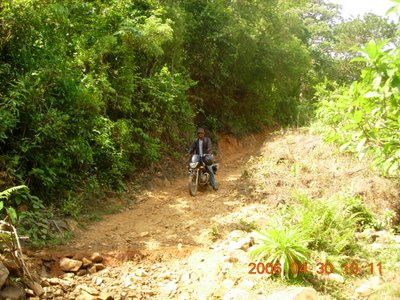 It was not a plain road track; it was full of ups and downs. I felt as though we are doing some cross road race without any audience. On the way we came across a triangle like path, where we got stuck as we did not know which one to take. So we rested there as Vineet took right turn and went ahead to confirm the road with any villagers who may come across. Then he came back and told left road takes to Kurkemane village while right road takes to JagaTa village. So we continued the ride after taking right turn. As we are coming down near to JagaTa village, we had to cross small channel of water which was flowing into farm where it was used to water the plants I guess. After crossing that, immediately we came to a halt. We could see JagaTa village in front of our track. But there was one big hurdle which we rode all this way to experience this. There was river flowing between us and JagaTa village and we must cross this now to continue our journey.
It was not a plain road track; it was full of ups and downs. I felt as though we are doing some cross road race without any audience. On the way we came across a triangle like path, where we got stuck as we did not know which one to take. So we rested there as Vineet took right turn and went ahead to confirm the road with any villagers who may come across. Then he came back and told left road takes to Kurkemane village while right road takes to JagaTa village. So we continued the ride after taking right turn. As we are coming down near to JagaTa village, we had to cross small channel of water which was flowing into farm where it was used to water the plants I guess. After crossing that, immediately we came to a halt. We could see JagaTa village in front of our track. But there was one big hurdle which we rode all this way to experience this. There was river flowing between us and JagaTa village and we must cross this now to continue our journey.
We walked across the river leaving the bikes on the bank to test how much deep it is. Luckily, it was coming to little less than our knees which was safe for only 150CC bike silencers (Mine and Mayya). Jagga inspected left side where their bikes could go without any problem to the silencers as it wasn’t deep that side. So first we all removed our shoes and took our entire luggage to that side of the road. The villagers saw us and they were happy to help us out of that river. They told us the stories of first bikers (7 to 8 ppl) who came in spite of pathetic roads. There was huge tree fallen on their path it seems and they had to lift their vehicles over that and come here. The water was also very much deep that time it seems and villagers were really surprised and shocked to see these people cross this river with their bikes. We then took our bikes one by one through the river. The river was full of pebbles of various sizes so we had to carefully cross the river without falling.
Finally all our bikes were parked opposite to the bank of river. The villagers were very helpful to us. They showed the hanging wooden bridge on the left side which they used to cross when the river rises to high level. They offered us drinking water which was very clean and sweet. They asked us whether we required breakfast. As we had already taken bread and jam for breakfast, we did not go for it. We had our breakfast under a shadow of big tree at around 9.30 AM. I took some beautiful of snaps of flowers in that village.
 Vineet was trying to capture photos of Swan flying on trees with his analog SLR camera while Mayya and Jagga were nagging him that he cannot use his camera properly.
Vineet was trying to capture photos of Swan flying on trees with his analog SLR camera while Mayya and Jagga were nagging him that he cannot use his camera properly.After thanking villagers, we were set to ride to our next destination “Nagarhole Railway Bridge” which comes near Edukumeri Railway station (Regular trekkers would know this name). This journey was toughest one compared to whatever we did until now. To tell how the path is, I can say my bike fell 4 times on the way without any damage to myself.We were riding bikes on the route which are supposed to be for trekking. So obiviously, it will be difficult. The route was asphalted road until we reached Hongadahalla village and continued our journey further towards track.
I hate this type of roads which was full of palm size pebbles and with ups and downs. But risk has its own value that’s why we were ready to take this as challenge. The distance was some 15 kms but the journey took long time. While going down, we had to go inch by inch applying back and front breaks. While going up, we had to be in first gear and full accelerator. This was our regular routine drive on that path. On the way we came across flat road with tall trees surrounding and some cut woods lying on left side of road.
There we took some snaps and we continued our journey. We came across beautiful scenery on the way where we would stop our vehicles and take snaps.
By 11.30 AM, we came to final destination where we could see Railway Bridge on right side. We parked our vehicles nearby and walked towards Railway Bridge. There were tunnels on either sides of the bridge. Jagga was very happy as he was doing trekking first time on this Edukumeri track by crossing bridges and tunnels. We did not know which one takes us to Nagarhole Railway Bridge. So first we took left side of bridge and walked on the wooden planks of bridge.
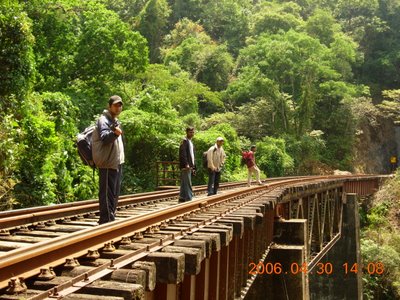 My legs were shaking as I was very much afraid of heights. Gradually, I became used to walking on the bridge. We crossed the bridge and all others went inside the tunnel except me as I had already been there. It was 2.00 PM already so we decide to move on. We had thought initially there could be path to Gundya which comes on the highway. Vineet took his bike, crossed the railings with great difficulty by using few slabs in slanting position.
My legs were shaking as I was very much afraid of heights. Gradually, I became used to walking on the bridge. We crossed the bridge and all others went inside the tunnel except me as I had already been there. It was 2.00 PM already so we decide to move on. We had thought initially there could be path to Gundya which comes on the highway. Vineet took his bike, crossed the railings with great difficulty by using few slabs in slanting position.  He went to either side where there was road visible to check whether it leads to Gundya or not. Later he came back and told there was no road. There came few railway workers who told us there is no way to Gundya and to visit Nagarhole Railway Bridge, we have to take right side of tunnel. While we prepared to leave, a single open carriage with some trekkers sitting on it passed on the track. May be they were going to Edukumeri railway station which was some 4 kms away to our left. We crossed the tunnel on right side and crossed one more small bridge. Then we had to cross longest tunnel existing in that track which is of 572mts. We switched on our torches and went through the tunnel to reach our destination Nagarhole Railway Bridge. The bridge was longest one and was at great height with Nagarhole River flowing underneath it. We walked across this bridge and then we climbed down to Nagarhole River with the help of passage like road on right side of bridge.
He went to either side where there was road visible to check whether it leads to Gundya or not. Later he came back and told there was no road. There came few railway workers who told us there is no way to Gundya and to visit Nagarhole Railway Bridge, we have to take right side of tunnel. While we prepared to leave, a single open carriage with some trekkers sitting on it passed on the track. May be they were going to Edukumeri railway station which was some 4 kms away to our left. We crossed the tunnel on right side and crossed one more small bridge. Then we had to cross longest tunnel existing in that track which is of 572mts. We switched on our torches and went through the tunnel to reach our destination Nagarhole Railway Bridge. The bridge was longest one and was at great height with Nagarhole River flowing underneath it. We walked across this bridge and then we climbed down to Nagarhole River with the help of passage like road on right side of bridge.We enjoyed taking bath in the flowing water. Mayya, Vineet and Kiran swam for some time. At around 3.30 PM, we had our lunch on the rocks nearby river. We looked up the bridge and we saw a group of 8 to 9 trekkers crossing the railway bridge. After finishing our lunch, we came back to our bikes. May be those trekkers would have got surprised to see bikes standing in this type of area. While we drove back the same route as there was no alternative. Those trekkers were having bath near some small flowing water next to our bikes. They may have thought we were crazy to drive these bikes on this type of terrain.
 On the way, my bike again fell down for 5th time and this time along with me. I got some bruises on my elbow, but was able to manage it. We came to same place (near Hongadahalla village) where there was full of tall trees standing at around 5.00 PM. We decided to hook the tent there itself as there was good air blowing up. Vineet and I went to left side of mountain to get Sun Set View Point while others rested on their mats. We both climbed on right side also to mark Sun Rise View Point to get good snaps in the early morning.
On the way, my bike again fell down for 5th time and this time along with me. I got some bruises on my elbow, but was able to manage it. We came to same place (near Hongadahalla village) where there was full of tall trees standing at around 5.00 PM. We decided to hook the tent there itself as there was good air blowing up. Vineet and I went to left side of mountain to get Sun Set View Point while others rested on their mats. We both climbed on right side also to mark Sun Rise View Point to get good snaps in the early morning.At 6.30 PM, as the sun was coming down, we all 5 went to Sun set view point to take snaps. There were huge boulders standing on that place. We sat on that rocks and waited for our precious catch of Suns image. We took several snaps as the sun was going down.
I asked Mayya to stretch his hands in front and I took a snap of him which looks like he is holding sun on his palm.
 By 7.00 PM, Vineet and I drive down to nearby village 2kms away to get some food as we heard there was one hotel in that village. But when we reached there, the hotel was closed down and there was no curds packet available to eat with our food. We tried asking one more shop but it was in vain. We met a man who called himself as Secretary. He said he wanted to help but told his assistant is not there to cook food so was unable to. He said if we want, we can cook food ourselves in his room. And he said he will arrange room for sleeping. We told him we had brought tent so we would be sleeping in that. Then to try our luck again, we went to back to that same hotel, where the hotel fellow was standing. Initially he said there was no food available and after some discussion, he agreed to give rice and sambar if extra is present in his house. Later on he gave sufficient amount of rice and sambar to us. He warned us from not to sleep outside as there was elephant attacks recently in surrounding villages. We went back to our tent and rest were also ready to leave the place as one of passerby told them it would rain in the morning. So with reason of rain and elephants, we decided to go for a room in HongadaHalla village. So we kick started our bikes and drive down to this village to reach at 8.00 PM. The villagers were very helpful especially Head Master of the school. He gave us room initially, but we settled for “Ranga Vedhike” which was in open space as we required some cool fresh air.
By 7.00 PM, Vineet and I drive down to nearby village 2kms away to get some food as we heard there was one hotel in that village. But when we reached there, the hotel was closed down and there was no curds packet available to eat with our food. We tried asking one more shop but it was in vain. We met a man who called himself as Secretary. He said he wanted to help but told his assistant is not there to cook food so was unable to. He said if we want, we can cook food ourselves in his room. And he said he will arrange room for sleeping. We told him we had brought tent so we would be sleeping in that. Then to try our luck again, we went to back to that same hotel, where the hotel fellow was standing. Initially he said there was no food available and after some discussion, he agreed to give rice and sambar if extra is present in his house. Later on he gave sufficient amount of rice and sambar to us. He warned us from not to sleep outside as there was elephant attacks recently in surrounding villages. We went back to our tent and rest were also ready to leave the place as one of passerby told them it would rain in the morning. So with reason of rain and elephants, we decided to go for a room in HongadaHalla village. So we kick started our bikes and drive down to this village to reach at 8.00 PM. The villagers were very helpful especially Head Master of the school. He gave us room initially, but we settled for “Ranga Vedhike” which was in open space as we required some cool fresh air.
We had our dinner at 8.30 PM and slept on our mats. We did not use tent this time. We got up at 5.30 AM morning next day and by 6.00 AM we were on the roads towards Sakleshpura.
 5 kms before Sakleshpura, we came across our one more destination “Majrabad Fort” also called as “Summer Palace” at around 9.00 AM. This is situated near to the highway so it is hard to miss. We had Badam milk and Tea at hotel and started climbing up towards the Fort leaving our bikes near the hotel itself. While walking up, we came to series of steps (around 200 I guess) which lead to Fort. We reached the fort to be amazed by its beauty.
5 kms before Sakleshpura, we came across our one more destination “Majrabad Fort” also called as “Summer Palace” at around 9.00 AM. This is situated near to the highway so it is hard to miss. We had Badam milk and Tea at hotel and started climbing up towards the Fort leaving our bikes near the hotel itself. While walking up, we came to series of steps (around 200 I guess) which lead to Fort. We reached the fort to be amazed by its beauty.We hired a guide to tell about its history. This Fort was built by Tippu Sultan. There are 3 Doors to the Fort. It was mainly built to collect and store revenue taxes. Instead of taking all money to Mysore, Tippu wanted to have central place to store the money, hence this fort. The fort is in the shape of stars with 9 sides, each side having watch tower to watch enemies entering. There is huge channel on all sides of fort which was earlier filled with water and crocodiles and poisonous snakes were let into it to avoid enemies. Other than 9 watch towers, there is one extra watch tower which is in front of the fort and looks magnificent with sculptures.
 The fort has swimming pool at the center in the shape of Plus sign with steps all around it. We went inside the Watch Tower to have experience how the guards watched the building. We stood on top of tower and took some beautiful snaps. The guide showed us the place where Servants room, the kitchen, Bath room were located which are already destroyed by British. He showed us Tippu’s Toilet place which also had separate corner for his bodyguard to watch any enemy entry. He showed us Horse stable, Tippu bedroom, the storage room to store all grains and the storage room for arms. There was escape route to outside on top of the fort. The most thrilling monument was there were 2 escape routes near the swimming pool. These are underground passages used to escape on their horses. The left one leads to Mysore and right leads to Srirangapatna. These escape routes are cured by Govt. of India to protect them from climate changes. The Govt. has blocked the escape routes as there was some rape incident 12 years back in that secret passage. He showed us how the walls of the fort
The fort has swimming pool at the center in the shape of Plus sign with steps all around it. We went inside the Watch Tower to have experience how the guards watched the building. We stood on top of tower and took some beautiful snaps. The guide showed us the place where Servants room, the kitchen, Bath room were located which are already destroyed by British. He showed us Tippu’s Toilet place which also had separate corner for his bodyguard to watch any enemy entry. He showed us Horse stable, Tippu bedroom, the storage room to store all grains and the storage room for arms. There was escape route to outside on top of the fort. The most thrilling monument was there were 2 escape routes near the swimming pool. These are underground passages used to escape on their horses. The left one leads to Mysore and right leads to Srirangapatna. These escape routes are cured by Govt. of India to protect them from climate changes. The Govt. has blocked the escape routes as there was some rape incident 12 years back in that secret passage. He showed us how the walls of the fortKeep cool climate even in summer. Hence it was called Summer Palace as Tippu used to come here in summer to have cool climate.

Near to first entrance, on the ceiling we can see the map of the entire fort with star shape with 9 sides including the channel that surrounds the fort. The secret passages are not depicted on this. We came down to our bikes and started towards Bangalore on the NH-48 highway. On the way, we come across 4 ways junction, left road takes us to Hassan and while straight road takes to Bangalore. We continued towards Bangalore with full speed 100Km/hr. Now the bike race actually started. Of course nobody can beat Mayya on Highways. We took left turn towards place called Nuggehalli 2kms after CR Patna. We biked 15 kms towards our final destination “Narasimha Temple” built by Hoysalas.
 We went inside the temple to find doors closed. We hired a guide there again and he took over all the idols carved on the temple explaining each one of them. The idols start with ‘Brahma’ god and ends with ‘Surya’ god. The other idols consist of Ganesha with eight hands, Harihara, Krishnavatara, Vamanavatara, Parvathi, Kaali, Lakshmi, Saraswathi, Rama, Sita, Lakshmana, Hanuman, Garuda, Vishnu sitting on snake etc. the Polari came and opened the door for us. Inside there were 3 god idols including ‘Ugranarasimha’ god. He did pooja and gave us teertha. At around 2.00 PM, we started to leave to Bangalore. On the way we went to my Aunty house at Mullukere 5kms from Nuggehalli. We had curd milk, tea and then left to Bangalore.
We went inside the temple to find doors closed. We hired a guide there again and he took over all the idols carved on the temple explaining each one of them. The idols start with ‘Brahma’ god and ends with ‘Surya’ god. The other idols consist of Ganesha with eight hands, Harihara, Krishnavatara, Vamanavatara, Parvathi, Kaali, Lakshmi, Saraswathi, Rama, Sita, Lakshmana, Hanuman, Garuda, Vishnu sitting on snake etc. the Polari came and opened the door for us. Inside there were 3 god idols including ‘Ugranarasimha’ god. He did pooja and gave us teertha. At around 2.00 PM, we started to leave to Bangalore. On the way we went to my Aunty house at Mullukere 5kms from Nuggehalli. We had curd milk, tea and then left to Bangalore.On the way, I saw a man driving a bike standing on the pedals of his bike with his hands folded. I was shocked to see that and I gave thumbs up sign and he acknowledged by bowing down. We reached Bangalore at 6.30 PM. And at last we had Lemon Tea at 7.00 PM at Kiran’s favorite hadda to mark our successful journey. Cheers!!!!...
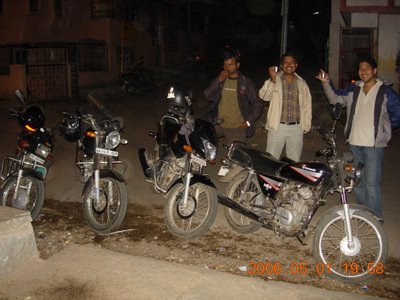
Tuesday, April 04, 2006
Why Do We Follow Those Custom Rituals? Why Why Why?
Answers of why...
1. Why do we light a lamp?.
2. Why do we have a prayer room?.
3. Why do we do namaste?.
4. Why do we prostrate before parents and elders?.
5. Why do we wear marks (tilak, pottu and the like) on the forehead?.
6. Why do we not touch papers, books and people with the feet?.
6a. To touch another with the feet is considered an act of misdemeanor. Why is this so?.
7. Why do we apply the holy ash?.
8. Why do offer food to the Lord before eating it?
9. Why do we fast?.
10. Why do we do pradakshina (circumambulate)?.
12. Why do we regard trees and plants as sacred?.
12a. Why do we ring the bell in a temple?.
13. Why do we worship the kalasha?.
14. Why do we consider the lotus as special?.
15. Why do we worship tulasi?.
16. Why do we blow the conch?.
17. Why do we say shaanti thrice?.
18. Why do we offer a coconut?.
19. Why do we chant Om?.
20. Why do we do aarati?.

In almost every Indian home a lamp is lit daily before the altar of the Lord. In some houses it is lit at dawn, in some, twice a day – at dawn and dusk – and in a few it is maintained continuously (akhanda deepa). All auspicious functions commence with the lighting of the lamp, which is often maintained right through the occasion.
Whilst lighting the lamp we thus pray:



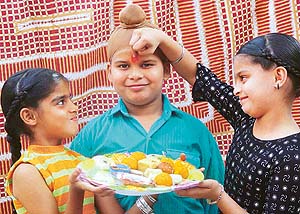

 The ash of any burnt object is not regarded as holy ash. Bhasma (the holy ash) is the ash from the homa (sacrificial fire) where special wood along with ghee and other herbs is offered as worship of the Lord. Or the deity is worshipped by pouring ash as abhisheka and is then distributed as bhasma.
The ash of any burnt object is not regarded as holy ash. Bhasma (the holy ash) is the ash from the homa (sacrificial fire) where special wood along with ghee and other herbs is offered as worship of the Lord. Or the deity is worshipped by pouring ash as abhisheka and is then distributed as bhasma. 
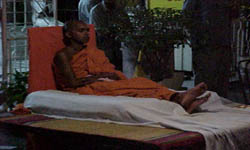
10. Why do we do pradakshina (circumambulate)?
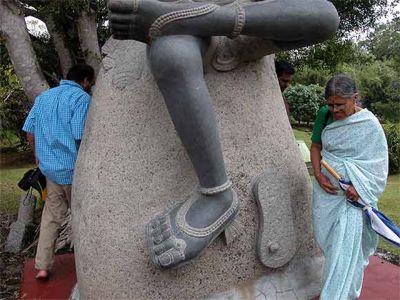



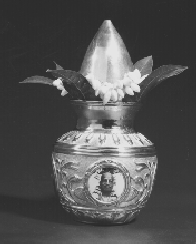






Puttannanavara Chitragala Vivara
Kannada chitra rangada bangaaradha yuga (Golden age of Kannada film industry)

One of the doyens of Kannada film industry, a committed person to make Kannada films shine in the international scene, a perfected technician, a person of great social responsibilities, and above all a person who knew the ins and outs of film making. Mr. Puttanna Kanagal represented the Indian directors in a director's summit in Russia.
He is one of the greatest filmmakers who transcended the technical limitations of his time in filmmaking. His film "Maanasa Sarovara" is one of the finest on human psychology. His portrayal of "AmruthaghaLige" i.e., "The most auspicious moment" in the film "AmuthaghaLige" is his concern for Social change. His depiction of the tenderness of love in "Saakshaatkaara" shows his ability to handle an otherwise boring story in a way liking to the audiences.
Below I would like to list his works in Kannada. His works, though includes films in Telugu, Tamil, Hindi and Malayalam, are very few and so a list of them is given at the end. His works are only mentioned here. His works are best understood by watching them in action. My inert pen cannot convey all the action he brought on the screen. This is a small tribute to a great personality who made a considerable value addition to the world of filmmaking.
1) Bellimoda (literally means-Silver Cloud)
A film with close association with the literary personalities of Kannada. The film is based on Ms. Triveni's Novel "bekkina kaNNu". It has a few wonderful songs which are hummed even today. Dr. Da. Ra. Bendre's "mUDaNa maneyA muttina nIrina erakaava hoydaa" brings on the scene the "minugutaare" (shining star) .
Kalpana, who later worked with the director in another similar film called "sharapaMjara". She played tragic roles in both the films, which displayed her as a complete actress. Mr. Puttanna was restless to see the morning Sunrise in black and white, which he could see in colour through his camera but not on the silver screen. This film started a generation of good movies which led the golden age of Kannada film industry. Mr. Puttanna wandered one full week to search a tree from where the sunrise would be grand to match the lines of Dr. Bendre's lines, and he finally could locate one near Chickmagalur (The coffee district of Karnataka), and this tree has additional significance in the film.
Cast: Kalyan Kumar, Kalpana, Pandari Bai, Ashwath
Songs: Dr. Da.Ra. Bendre, Vijayanarasimha
Music: Vijayabhaskar
2) Mallammana Pavaada (1969)
A village leader's son is drugged and made dumb by his own step mother who wants her "own" son to get the property of her husband. To culminate the dumb fellow's fate she gets him married with a village lass (Mallamma), who educates him-besides getting herself educated. Thus she makes him capable of understanding what is happening around. Sounds the storyline is familiar? Yes you are right, the Hindi movie "beTa" is a poor copy of this Puttanna's original movie. Unfortunately Ravichandran made this very movie in Kannada as a remake (Annayya). An astoundingly good social story line wonderfully narrated by Puttanna made ripples in the filmdom and paved the way for some really good movies. As a typical characteristic of Puttanna Kanagal's movies, this film also has good music, wonderful display of characters. Listen to "Ever Lively" L.R. Eshwari's song "aashaa vilaasi".
Cast: Dr. Rajkumar and others
Songs: Kanagal Prabhakar Shastry
Music: Vijaya Bhaskar
3) Kappu Bilupu (1969)
A movie with the highlight of Puttanna's movies, i.e., fine music. Listen to P. Susheela's Golden hour, the song "ee chendada maneyalli" and "amma ninna tOLinalli kaMda naanu"
Cast: Rajesh, Kalpana and others
Songs: R.N. Jayagopal
Music: R. Ratna
4) Gejje Puje (1969)
A film to bring social awareness about a rampant problem of all times. This story is about a woman who is branded a "whore", and about how her child is innocently wants to know what it really means. A brilliant acting by Ashwath, Lokanath and Leelavathi. The film also has the portrayal of the innocence of childhood which is a common feature in Steven Spielberg's films.
The usual highlights of Puttanna's films like, carrying the audience without boring, good songs, sensible story handling and with a social touch are well witnessed in the movie. Songs like "gagnavu ellO.. bhUmiyu ellO..", "paMchamavEda prEmada naada" are from this movie.
Cast: Ashwath, Leelavathi, Lokanath and others
Songs: Vijayanarasimha
Music: M. Ranga Rao
5) KaruLina Kare (1970)
Dr. Raj and Puttanna together make this a fine movie. Listen to the song "maisUru dasara, eshToMdu suMdara" by P.B. Srinivas
Cast: Dr. Rajkumar, Renuka, Kalpana and others
Lyrics: R.N. Jayagopal
Music: M. Ranga Rao
6) Sharapanjara (1971)
 Probably actress Kalpana's best performance. The storyline deals with human psychology. Has best music with songs like "biLigiri raMgayya", "uttara dhRuvadiM dakshiNa dhruvakU", "koDagina kaavEri", "saMdEsha mEgha saMdEsha".
Probably actress Kalpana's best performance. The storyline deals with human psychology. Has best music with songs like "biLigiri raMgayya", "uttara dhRuvadiM dakshiNa dhruvakU", "koDagina kaavEri", "saMdEsha mEgha saMdEsha".One more interesting thing is Puttanna could make heroine centric films like this one and make them commercially successful. So, it was the director's movie rather than a hero's movie.
Cast: Kalpana, Gangadhar
Songs: Dr. Da.Ra. Bendre, Vijayanarasimha
Music: Vijayabhaskar
7) Sakshathkara (1971)
One of the finest movies I have ever seen. The tenderness of love is depicted at its best. Has the best music. Has Dr. Raj with Puttanna for the third time (after Mallammana Pavada and Karulina Kare). Never to miss the song "olave jeevana saakShtkaara". Also has Narasimharaju with some real good humour. Mr. Prithviraj Kapoor has given one of his greatest performances as father of Dr. Raj in the movie.
Cast: Dr. Raj, Vajramuni, Jamuna, Narasimharaju, Prithviraj Kapoor, Balakrishna
Songs: Kanagal Prabhakara Shastry
Music: M. Ranga Rao
8) Nagara Haavu (1972)
This movie gave two actors to Kannada film industry, who later went on to get millions of fans. This movie introduced Vishnuvardhan (Puttanna renamed "Kumar" as Vishnuvardhan and told he should become as famous as the king by the name) and Ambarish. This is the only movie which had Vishnuvardhan in all of Puttanna's movies. After this movie, Chitradurga and its surroundings became tourist places. The movie has finest music and a song introduces 'Abhinaya Sharade' Jayanthi as 'Obavva'- the wife of a watch guard who became immortal after the war that followed.. Jayanti still remembers this role of her as her career's best performance. One more important thing is the versatility Puttanna brought in each of his films. Jayanthi though had a historical role, in her next project with Puttanna, she was given a role of 'fallen lady' in the film 'Edakallu guddada mele'. This movie is based on the novel by another famous writer of Kannada Mr. Ta. Ra. Subbarao.
Cast: Vishnuvardhan, Ambarish, Shivaram, Ashwath, Leelaavathi
Songs: Vijayanarasimha, R.N. Jayagopal
Music: Vijayabhaskar
9) Edakallu Ghuddadha mele (1973)
The movie has a social storyline. Jayanthi and Arathi have given their finest performances. Chandrashekhar (the hero of the movie) is caught between morals and pleasure. Has some of the finest songs of all times. The song "viraha nUru nUru taraha" personified Vijayanarasimha as "Virahanarasimha". Other humming tunes from the movie are "saMOsha Elu svaragaLa", "nillu nille pataMga", "saMnyaasi arjuna saMnyaasi", "guMDina mattE gammattu" still have their top position among good musical hits.
Cast: Chandrashekhar, Jayanthi, Arathi and others
Songs: Vijayanarasimha,
Music: M. Ranga Rao
10) Upaasane (1974)
A musical extravaganza. The film has a spiritual storyline. The music is the highlight of the movie. The movie is undeclared tribute to the trinities of Carnatic music (Shyama Shastry, Thyagaraja and Muttuswami Dikshitar). The lyricists have rendered their best creative works for the movie. I cannot point out a single song as movie's highlight. The songs "bhaaratha bhooshira", "bhaavaveMba hoovu arali", "aachaaravillada naalige" are fantastically adopted in the film.
Cast: Arathi, Leelavathi, Laxmidevi, K.S. Ashwath, S. Seetharam, Vajramuni, Musuri Krishnamurthy
Songs: Purandhara Dasaru, Vijayanarasimha, Chi. Udayashankar
Music: Vijayabhaskar
11) Shubha MaMgaLa (1975)
Puttanna's portrayal of Shubha Mangala (meaning the reunion) is the uniting of the lovers. Film has a fine story, fine songs. Srinath appeared for the first time in Puttanna's film. Srinath's image as "Pranaya Raja" is depicted through the song "Hoovondu baLibaMdu".
Cast: Srinath, Arathi, Shivaram and others
Songs: Vijayanarasimha, M.N. Vyasa Rao
Music: Vijayabhaskar
12) Kathaa Sangama (1975)
Puttanna's prolific capability of writing the story script is well exhibited through this movie. Obviously the story was fantastic and the technical work.
Cast: Rajnikanth,Arathi and others
Songs: Vijayanarasimha
Music: Vijayabhaskar
13) Bilee Hendti (1975)
This film brought Kasthuri Shankar who sang the song "raMgEna haLLiyaage" with Vani Jayaram. The film has a tragic storyline. The tragic story is very well handled by Puttanna. The song "raMgEna haLLiyaage" is taken from a popular folk story which I had heard in our homes. The songs popularity inpired the making of another film with the name "raMgEna haLLiyaage raMgaada raMgEgouDa".
Dont' miss to listen to the song "yaava taayiyu paDeda maganaadarEnu"
Cast: Arathi,Anil Kumar,Margaret Thompson,Leelavathi
Songs: Vijayanarasimha
Music: Vijayabhaskar
14) Phalitamsha (1976)
The film brought "Mogambo" Amarish Puri into Kannada films. A fine movie with good music and a very good story. Listen to Vani Jayaram in the song "Love eMdare..."
Cast: Amarish Puri and others
Songs: Vijayanarasimha, Shyamasundar Kulkarni, R.N.Jayagopal
Music: Vijayabhaskar
15) Kaaleju RaMga (1976)
Some spirited music and "metallica" like songs. A film made in a different dimension then Puttanna's usual way. The songs like "Colleju raMgadalli". The story unfolds in a college campus.
Cast: Ambarish and others
Songs: Vijayanarasimha, Chi. Udayashankar
Music: Upendrakumar
16) Paduvaarahalli Paandavaru (1978)
One of the finest movies comparable to anytime anywhere movies.
Five people fight against the misdeeds of the so called "head" of a village and his followers. Has some of the finest songs like "janma neeDida bhUtaayiya", "tUkadisi tUkaDisi bILadiro tamma". Puttanna's careful observation has not left to expose how Hindi can be a language of deceit through two characters who claim not to know Kannada but only Hindi and collect money through the "head" of the Village and try to flee the village. But through dramatic events they get caught. Not to miss the song "kaNNa muchchi kuLitare", "Esu varsha aithe niMge"
Cast: Ambarish, Ramakrishna, Jai Jagadish, Ashok, Dhirendra Gopal, Arathi and others
Songs: Vijayanarasimha, R.N. Jayagopal
Music: Vijayabhaskar
17) Dharmasere (1979)
Remember the songs "kaMdaa, O muddu kaMdaa.." and "mUka hakkiyu haaDutide", "ee saMbhaaShaNe namma I prEma saMbhaaShaNe"? These superb songs are from this movie. The movie has a very touching storyline.
Cast: Arathi, Srinath, Musuri Krishnamurthy and others
Songs: Vijayanarasimha
Music: Upendrakumar
18) Ranganaayaki (1981)
 Another gem of a movie which won the national award for Puttanna and for Kannada. The story has a daring subject in which one falls in love his own mother not knowing she is his mother. The tragic ending ends the life of "raMganaayaki". Ambarish, Ashok, Ramakrishna, Arathi have given their finest performances in this movie. Fine songs like "jai jagadaMbe", "maMdaara pushpavu neenu", "kannaDa naaDina rasikara manavaa", "jai hRudaya jhEMkaara" and some of
Another gem of a movie which won the national award for Puttanna and for Kannada. The story has a daring subject in which one falls in love his own mother not knowing she is his mother. The tragic ending ends the life of "raMganaayaki". Ambarish, Ashok, Ramakrishna, Arathi have given their finest performances in this movie. Fine songs like "jai jagadaMbe", "maMdaara pushpavu neenu", "kannaDa naaDina rasikara manavaa", "jai hRudaya jhEMkaara" and some ofthe adoptations of "raMgabhUmi" (theatrical music) are the highlights of the movie.
Cast: Ambarish, Arathi, Ashok, Ramakrishna, Musuri Krishnamurthy and others
Songs: Vijayanarasimha, R.N. Jayagopal
Music: M. Ranga Rao
19) Maanasa Sarovara (1982)
While Srinath proved that he is an actor of content, Ramakrishna got the image of a playboy through this movie. This movie also introduced another fine actress Padmavasanthi. The movie is concpicuously important as this was made after a similar tragic incident in the life of Puttanna. Some never to miss songs like "vEdaaMti hELidanu", "maanasa sarOvara", "cheMda cheMda", and Poet G.S. Shivarudrappa's poem "haaDu haLeyadaadarEnu" are simply superb and their picturization. The dialogues are awe inspiringly simple and good.
The movie won Puttanna awards and accollades. Vijayanarasimha penned a song which was a tribute to Puttanna "O guNavaMtha, O guNavaMtha" (in the movie masaNada hUvu).
The movie is filmed in Sandur and nearby places. The location, the songs, the picturization are all wonderfully crafted to bring the poetic moments Puttanna wants to bring in the minds of audiences.
Cast: Srinath, Ramakrishna, Padmavasanthi, Mysore Lokesh, Vaishali Kasaravalli
Songs: Vijayanarasimha, R.N. Jayagopal, Dr. G.S. Shivarudrappa and others
Music: Vijayabhaskar
20) Dharani Mandala Madhyadolage (1983)
Listen to the song "geLati O geLati", fantastic picturisation
21) RuNamuktaLu (1984)
Puttanna was a producer for this movie. Even with his money he made films of social awareness like this one. The film has fine songs and a very touching storyline.
Cast: Padmavaasanthi, Bhaarathi
22) Amtutha Galige (1984)
"A widow getting a new life" is how Puttanna depicts "amRutha ghaLige" (auspicious moment). The hero is a book worm and well mannered who marries his friend knowing that she was in love with another (Santhosh) friend of him. He lives with her and brings up "her" child. But conveys to Santhosh that he did a mistake and there is not point in continuing it any further. The film climaxes when Santhosh convinces the "window" to marry him. The moment when this happens Puttanna puts it the auspicious moment. The film has scenes from some of very good locations. Never to miss the songs like "hiMdUstaanavu eMdU mareyada", "paarvathi parashivara praNaya prasaMga" are from this movie.
Cast: Ramakrishna, Sridhar, Padma Vasanthi and others
Songs: Vijayanarasimha
Music: Vijayabhaskar
23) Masanada Hoovu (1984)
Vijayanarasimha rendered a song to commemmorate the memory of Puttanna "O guNavaMtha". The songs like, "masaNada hUveMdu nInEke koraguve" are still popular.
Cast: Ambarish,Aparna
Songs: Vijayanarasimha, R.N. Jayagopal
Music: Vijayabhaskar
